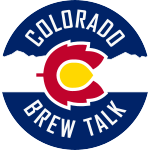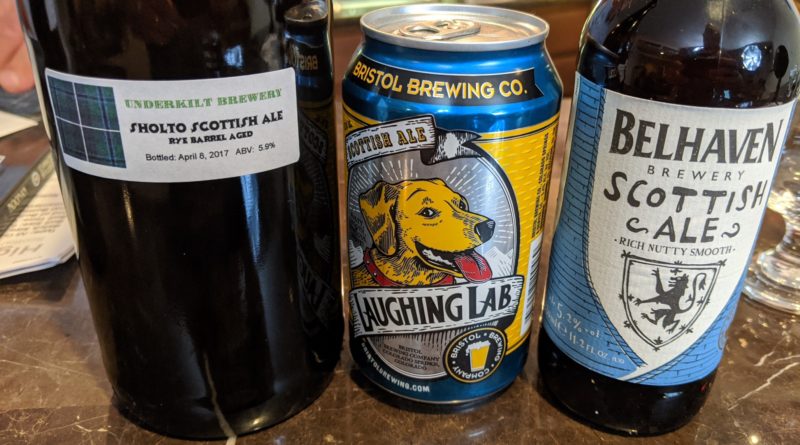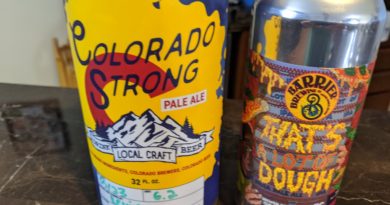Scottish Export Tasting – BJCP Category 14C
This episode we were able to get Don, a fellow Brew Brothers homebrew club member, he’s a “Scottish Beer Lover” and makes some really great examples of the style.
Our examples for this style are:
Scottish Ale – Belhaven Brewery
Dunbar, East Lothian Scotland
5.2% ABV – 28 IBU
and
Laughing Lab Scottish Ale – Bristol Brewing
Colorado Springs Colorado
5.4% ABV – 19 IBU
Laughing lab isn’t one of the BJCP examples, but was Winner of the Silver in the Scottish Ale category at the 1996 World Beer Cup®, the 2000 and 2006 Gold Medals, the 2007, 2002, 2001, and 1996 Silver Medals and the 1994, 2005 and 2010 Bronze Medals in the Scottish Ale category at the Great American Beer Festival®
We thought that maybe “Fuggle” is someone who can’t brew (for all you Harry Potter fans out there).
As we mentioned in the video, Don was nice enough to share his recipes with us. You can find them here:
- Don’s Sholto Scotch Ale – Scottish Export All Grain Homebrew Recipe
- Don’s Highland Session 60L – Scottish Light All Grain Homebrew Recipe
- Don’s Ole Scotch Ale – Wee Heavy All Grain HomeBrew recipe
- Don’s Archibald the Grim Scottish Light – All Grain Homebrew Recipe
Don recommends using 1 – 2 oz of peat smoked malt in a 5 gallon if you’re going to use it, but it’s not appropriate to the style. Caramelizing the first runnings is also a good idea. He likes to pull out a gallon of the first runnings, and then he reduces it by about a pint, and then adds it back to the boil. It adds a bunch of flavor and richness.
Don also pointed out that Hops were a late addition to Scottish brewing, before that they used, Bog murtle, which made you drunker faster, Broom (a bitter shrub), dandelion roots, orange peel, Darnel, Ginger, Juniper, Licorice, service berries, spruce shoots, watercrest, and wormwood. These additions aren’t to the BJCP style, but historically accurate. Hops weren’t used until around the mid 1800’s. Don likes to use Star Anise, adding one pod to the boil.
From the BJCP Description for Category 14C – Scottish Export
Overall:
A malt-focused, generally caramelly beer with perhaps a few esters and occasionally a butterscotch aftertaste.
Hops only to balance and support the malt.
The malt character can range from dry and grainy to rich, toasty, and caramelly
Never roasty and especially never has a peat smoke character.
History:
The shilling designation actually only referred to the cost of the barrel of the beer, but a single style wasn’t designated as a 60, 70, or 80 shilling.
Scottish Ales were termed Light, Heavy, and Export
Nearly identical, but as the gravity of the beer increases, so does the character.
Historically parti-gyled to different strengths
Aroma:
– Low to medium maltiness, often with flavors of toasted breadcrumbs, lady fingers, and English biscuits.
– Low to medium caramel and low butterscotch is allowable.
– Light pome fruitiness in best examples.
– May have low traditional English hop aroma (earthy, floral, orange-citrus, spicy, etc.).
– Peat smoke is inappropriate..
Appearance:
– Pale copper to very dark brown.
– Clear.
– Low to moderate, creamy off-white.
Flavor:
– Entirely malt-focused, with flavors ranging from pale, bready malt with caramel overtones to rich-toasty malt with roasted accents (but never roasty) or a combination thereof.
– Fruity esters are not required but add depth yet are never high.
– Hop bitterness to balance the malt.
– No to low hop flavor is also allowed and should of traditional English character (earthy,floral, orange-citrus, spicy, etc.).
– Finish ranges from rich and malty to dry and grainy.
– A subtle butterscotch character is acceptable; however, burnt sugars are not.
– The malt-hop balance tilts toward malt.
– Peat smoke is inappropriate.
Mouthfeel:
– Medium-low to medium body.
– Low to moderate carbonation.
– Can be relatively rich and creamy to dry and grainy.
Vital Statistics
OG: 1.040 – 1.060
IBUs: 15 – 30
FG: 1.010 – 1.016
SRM: 13 – 22
ABV: 3.9 – 6.0%




